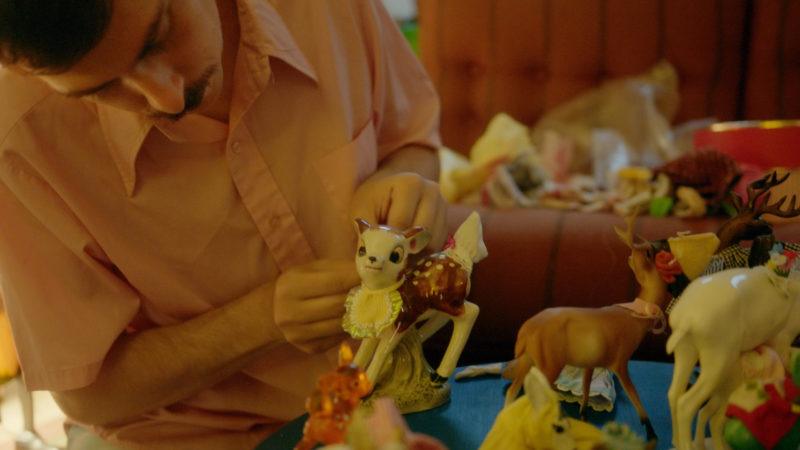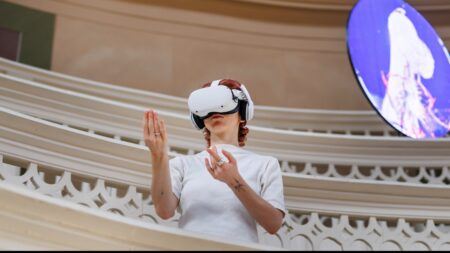
IMAGE: Production still from the New York Close Up film, “Adam Milner Takes Care of the Details.” © Art21, Inc. 2021.
Planning for the recent online program, Bringing Back Curiosity, featuring our very special guest, Lois Hetland, featured a series of email exchanges and conversations about teaching, the nature of curiosity in the classroom, and how we cultivate curiosity as educators and artists. In an effort to pull back the curtains on this process, I wanted to share some of the thinking that went into this particular event. Below are excerpts from our work and planning together…
Joe Fusaro: What does it take to be a good art educator these days, from your perspective? What do you say to young teachers just starting their careers in 2024?
Lois Hetland: What does it take to be a good art teacher now?
Courage, attentiveness, creativity, generosity, kindness, and perseverance.
Courage—to find a way to do what you know needs to be done within a system designed to stymie those things.
Attentiveness—You need to notice where you and kids are being squelched, to where your allies are, and to what people are particularly pernicious and obstructionist.
Creative and Generous—You need to build community with your students and with all the adults who work with them, and to find ways to continue extending invitations to everyone who seems not to want to budge from whatever fear or dis-ease is skewing them toward destructive practices.
Kindness—you need to forgive everyone all the time – with yourself in the forefront of that.
Persistence—you need to keep on putting one foot forward again and again, regardless of whether you appear to be getting anywhere. Nothing is ever built unless someone builds it—and that means addressing every time it starts to fall apart, or is deliberately taken apart. Persistence centrally requires taking care of yourself—errors are opportunities, but they also can feel like a kick in the gut. So sometimes—regularly—you just take a deep breath and continue. Other times—regularly—you take a break, a nap, a walk, or some other breather to let yourself recover. But then you come right back and take it all on again.
It’s funny—I started to say “relationship” is what it takes, and that might be a simpler way of saying everything above. Relationships certainly require all those qualities – courage, attentiveness, creativity, generosity, kindness, and persistence.
JF: So relationships are at the core?
LH: Relationships, or connection, are absolutely core. I don’t think anything happens without it. And when they’re broken, we need to fix it (or just keep limping forward until you can).
JF: Could you talk more about paying attention to being “squelched”? When I think about this in a school or school district context, I think about teachers paying attention to how their ideas for empowering kids, as well as using the power of art, is being stifled because too many districts see art education as an “extra,” or art as a discipline that’s not “core.” You and I believe Art is a core discipline, just like English or Science is regarded as a core discipline, but art educators are often faced with their discipline being seen basically as decoration. I’ve seen superintendents and principals, for example, walk into ceramics classes and delegitimize the whole experience by asking, “So this is the time kids get to play with clay?” Makes my head explode.
I’m also wondering about this idea of being kind. It’s hard to forgive all the time in this work. You and I know. Can you talk more about this? Who are we forgiving? And why?
LH: Hm, squelched….
I’m thinking of classes being canceled because of standardized testing. I’m thinking of teachers not getting their supplies for months—nearly a whole year—and having to “make do.” I’m thinking of people taking kids out of art because they need remedial work in reading or math. I’m thinking of principals who have no idea what an art teacher does, evaluating art teachers and giving them low ratings when they’re really appropriately attending to individual needs. I’m thinking of new teachers without the support of colleagues and mentors. I’m thinking of teachers being required to teach specific standards when their kids need and/or are fascinated by other topics and not by the requirements. And it can be worse—some teachers I just worked with are required to be on the same page of a district binder! Ai yi yi!
Kindness…. When the world gets dark—stressed, stretched, overwhelming—it’s easy to turn against each other and ourselves. Giving up.
I think about what I call the Creativity Diamond. You start with an intention, and then you open it out by diversifying the idea—spreading it into possibilities. Ultimately, you need to turn in toward a solution, and that requires a shift in direction as well as pruning of ideas to keep the best ones and synthesizing them. Hard work. In that section of the process where you’re turning from opening out to closing in, it’s hard. I call it the zone of dis-ease. And we recognize it by our mental talk—we find ourselves unkind. We blame everything. It’ll always be that way in the creative process—the zone of dis-ease doesn’t go away. Artists need to learn to manage it.
JF: You mentioning taking care of oneself in order to do this work also makes me think about the kinds of recommendations we might offer teachers in the arts- whether they feel like they’re drowning or not. Some examples we have already mentioned plus a few others so far:
Invite others, especially administrators and policy makers, into the classroom to sit with kids and learn with them.
Take care of yourself through rest and play. Give yourself time to balance all of the expectations and responsibilities through walks, playing with materials, going out for lunch instead of staying in the building, etc.
Make displays and bulletin boards opportunities for others to learn about learning in art vs. decoration for the school.
Teach inside AND outside of the classroom—use the school and community as a place teach and learn.
Make the “art of brainstorming,” and getting good ideas, part of the curriculum vs. relying on specific instructions for students to complete “projects.”
So what does curiosity look and sound like from your perspective?
LH: Here’s where I started in my teaching context—with an immersive curriculum of creating environments like deserts, the arctic tundra, underwater, and rain forests. We’d use recycled junk and make a spherical surround of that environment by researching plants and animals and landforms and then making them in situ. Then we’d live in the environment for a couple months, with kids touring guests as docents. The guests had questions, and the kids did more research if they couldn’t answer them and then got back to them.
But as I developed as a teacher, I started using overarching questions, what I call “Throughlines” to guide the curriculum. When I taught 7th grade, our year-long central subject was Colonial America. At that time, I was the teacher-researcher for a Harvard Project Zero study called Teaching for Understanding, and they wanted me to make our overarching essential questions public to the students—on the wall. I was resistant, but I did eventually do it (after about 14 months). I put 12 questions up, because I was terrible at pruning in those days. It was fine, because the ones that weren’t worth it just got ignored, and two or three kept rising up into the conversations, into the projects, into the thinking. The best one was the question: How can we find out the truth about what happened long ago and far away? That was memorable, because of Star Wars, and it foregrounded an important misconception that we had to address over and over—History isn’t about truth. It’s about warranted interpretations of documents. And it centered our inquiry—“How do we find out…” and suggested that we’d be doing this together. The good ones like this became a living presence in the classroom, guiding our inquiry all the time in all sorts of ways.
I guess the summary answer is: set up an engaging environment where questions and inquiry are at the center, and then set the kids exploring those questions together, learning to use the approaches, methods, and tools that experts use.
JF: In my classrooms over the years, curiosity is present when students lean in, and what I mean by that is that I usually see a physical reaction to the content where students might move closer, sit forward in their seats, or simply dive into making something and their body language says, “I’m into this. I’m discovering something here.” These are the points where I usually have to make a critical decision… Sit down and ask about what they’re working on, or have the good sense to leave them alone if they’re in a zone.
Another time when curiosity is present is when I ask questions and students follow up with questions. Too often, as teachers, we expect to be the one asking the questions and students answering in different ways. But what happens when we ask students to come up with questions? What happens when we ask students what they’re curious about when it comes to different topics and ideas in our curriculum? What can happen when the work we do with students is driven by big questions?
LH: Questions are both a vehicle to inspire curiosity and a demonstration of it. Questions focus attention, so we can use them to focus attention to something important, and when kids come up with them, the quality of their questions reveals their thinking and how they’re entering into/engaging with what’s important.
Questions also inspire dialogue. Someone asks, then someone answers, then answers again in another way, and then someone else answers, then a new question arises from those, and so forth—a collaborative inquiry unfolds. So public questions—raising them and then giving them time in the exploration and response to engaging experiences—provokes curiosity. Art does that.
Lois Hetland is a passionate educator. She’s the co-author of three editions of the popular books- Studio Thinking 1, 2, and 3, and of Studio Thinking from the Start, aimed at elementary and middle school. Lois is also a tireless advocate for art education.
Joe Fusaro is Art21’s Education Advisor and is also an exhibiting artist, educator, and director of the Teacher Center for the Nyack Public Schools in New York. He served as the visual arts chair for Nyack from 2003-2022, and prior to his work there he was an art educator and staff developer for the New York City Schools from 1990-2003. Fusaro is a member of the adjunct faculty at New York University’s Graduate Program in Art and Arts Professions and has led staff development workshops in contemporary art education for schools and museums across the country.




